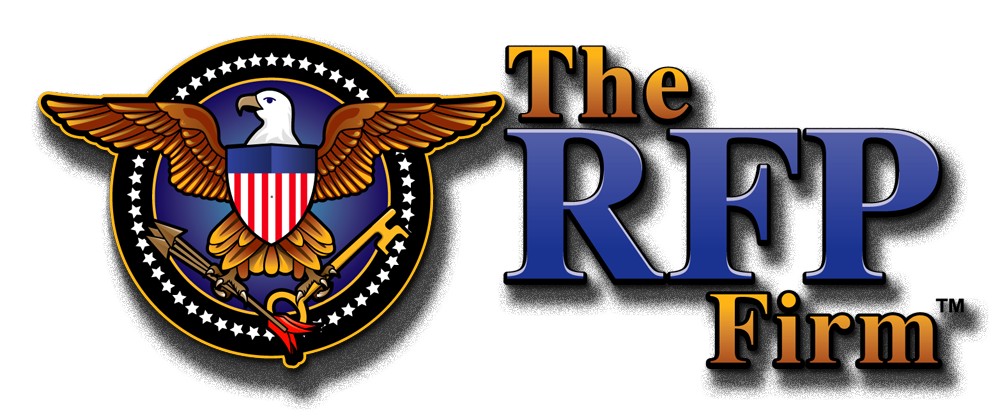Blog
Government & Commercial Proposal Writing Services
 The RFP Firm is expert at writing proposals in Response to Federal and State Government RFP Solicitations that will give you a Competitive Advantage over your competition.
The RFP Firm is expert at writing proposals in Response to Federal and State Government RFP Solicitations that will give you a Competitive Advantage over your competition.


Proposal Writing Services , RFP Proposal Consulting, Government RFP writing
Government RFP Proposal Writing Services
Government & Commercial Proposal Writing Services
 The RFP Firm is expert at writing proposals in Response to Federal and State Government RFP Solicitations that will give you a Competitive Advantage over your competition.
The RFP Firm is expert at writing proposals in Response to Federal and State Government RFP Solicitations that will give you a Competitive Advantage over your competition.

Small Business Proposal Tips & Tricks
There are many keys to preparing a government proposal for services by a small business. First is to understand that most government agencies (federal, state, and local) provide incentives for small business. This is often in the form of a set-aside where you must be a small business to qualify or additional points in their evaluation process when scoring your proposal.
Small Business Certifications
As a small business, you need to get certified in one or more categories including Small Business Enterprise (SBE), Historically Underutilized Business (HUB), Minority-owned Business Enterprise (MBE), Woman-owned Small Business (WOSB), Veteran-owned Business Enterprise (VBE), etc. Often, there are benefits that target these businesses or require subcontracting to meet the requirements.
At the federal level, and most local government agencies, government RFPs must follow the Federal Acquisition Regulations (FAR) when preparing agency proposals. FAR provides specific instructions on how they should organize the content and what sections need to be included as well as how the proposal is to be evaluated. As a result, these documents can be quite lengthy and details, often confusing as well to the novice. The main document of an RFP can be anywhere from 10 pages to many hundreds, plus all of the forms and other reference documents.
Registering Your Business
Most government agencies require you to register on their website as a prospective vendor. This way they have your basic corporate information and will set you up to receive any regular updates to the proposal, i.e., notices, amendments, addenda, etc. For federal solicitations, the government’s SAM.gov website is the primary location. You will need your federal tax id number or Employee Identification Number (EIN) and other basic corporate information. Once registered, you will receive a Universal Entity Identifier (UEI) Number and CAGE Code. This information is required for bidding on federal contracts.
A NAICS (North American Industry Classification System) number will enable the federal government to identify your area of business. Often you will need to identify several NAICS numbers to represent the breadth of your business. The Small Business Administration (SBA) can help with identifying these classifications.
Proposal Content
When responding to an RFP with a small business proposal, you will be competing with many other contractors so your responses to the specific requirements must be exact, to the point, but also set you apart as much as possible. This is typically accomplished by emphasizing your differentiators and other unique benefits that you bring to the contract.
The first step is to outline the content required for each and every section and volume of the proposal. Cover every single item including any compliance requirements. Then, as you start pulling together the content and completing all required forms and attachments, you will ensure that every section has been addressed and you are one hundred percent compliant.
If you are approached with an RFQ, Request for Quote, you have a much simpler job since the agency is mainly interested in the details of what it will take to accomplish their goals and a range of pricing so that when putting together the final RFP, they will have more confidence that their scope of work is viable. These are informal requests that do not normally lead to a contract.
Pricing
Eventually, your proposal will become part of the government’s contract, so your pricing should be clear and concise and not subject to misinterpretation. Support your pricing information with facts and other data. Often, they are looking for “reasonable” pricing which means that when compared with other bidders, you are within a reasonable percentage range of the average price being proposed. A proposal can get be considered unsatisfactory if it is either too high or too low, indicating that you may not fully understand the requirements. On the other hand, if the pricing criteria is a LPTA (Lowest Price Technically Acceptable), then you must propose the lowest price in order to win the bid.
Finding Government RFPs
Many firms looking to bid on a small business proposal find it very time consuming to find RFPs that they would be interested in bidding on. This process is often difficult and confusing. To help, there are several websites that offer subscription services where they go out and research the entire country for federal, state, county, and city RFPs. Then, they are able to send you specific solicitations that meet your selection criteria based on keywords and industry classifications you have identified. Once identified, responding to government RFPs can be very profitable. Contracts are typically 3-5 years with additional option years or even longer.
Federal, and most state agency, RFPs are required to comply with specific guidelines for issuing, preparing, and evaluating proposals submitted in response to vendor RFPs. The federal government especially has very detailed procurement guidelines that help to provide transparency and most government agencies must list their contract opportunities publicly.
This is not always the case though as there are times when the list of vendors has been prescreened and RFPs are sent only to those select companies. For example, the agency may be looking for a local company with state certification in their industry, so they acquire a list of companies certified by that industry’s association.
Should You Submit a Bid or Not?
Make sure that you are responding to an opportunity where you have the background and experience, that you have the key personnel and staff, and the financial resources to support the contract.
Review the Scope of Work/Services to ensure that you are a good fit for the required services. If you are an excellent fit for only a portion of the contract, you can create a Joint Venture entity or partner with a qualified sub-contractor for those other areas of expertise. This is quite common.
You need to have the time and resources to follow the guidelines in the RFP and read every word to ensure that you address all instructions and follow every compliance requirement. Even things like a requirement to have 1-inch margins can get you disqualified if not followed. The RFP Firm can help you prepare a compliant proposal that leverages your company’s strengths.
Your final deliverable should be double-checked to ensure that you have addressed all instructions and every requirement.